Types of Native American Jewelry by Tribe
Posted by Claudia on Dec 9th 2016
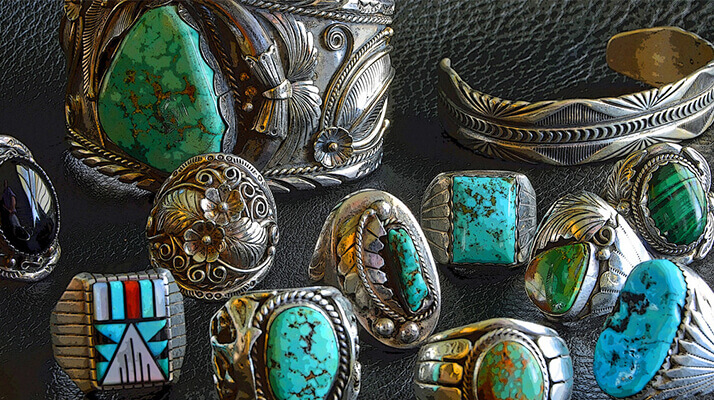
Indigenous peoples from the United States have been crafting and wearing exquisite jewelry for centuries. Long before the Europeans settled in America and introduced the natives to silversmithing, the Native American tribes used natural resources such as bones, stones, wood, shells, and turquoise to craft earrings, necklaces, pins, bracelets, and other pieces. Although there have been many types of native American jewelry over the years, a great deal of American Indian jewelry was crafted for function over fashion, such as brooches, bridles, and buttons.
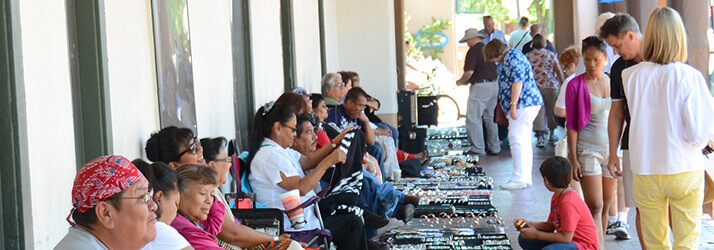
Native American Jewelry Remains Relevant Even Today
Long ago, the Native Americans used their jewelry as a sort of currency or collateral when trading with the European settlers, and jewelry making quickly become an indispensable element of the tribes’ economic survival. Today, American Indian artists keep this enduring tradition alive, crafting and selling authentic jewelry rooted in ancient traditions passed down from generation to generation. Buying authentic Native American jewelry also remains an excellent way to support local Native American artisans.
Native American jewelry is still prized for the incredible skill and craftsmanship that goes into each piece, as well as the timeless traditional designs that have become so recognizable. Genuine Native American jewelry continues to have significant cultural significance today, with many fashion-forward individuals choosing to wear it to complement both casual and formal attire. Here is a look at a few of the most common types of Native American jewelry that are still treasured to this day.
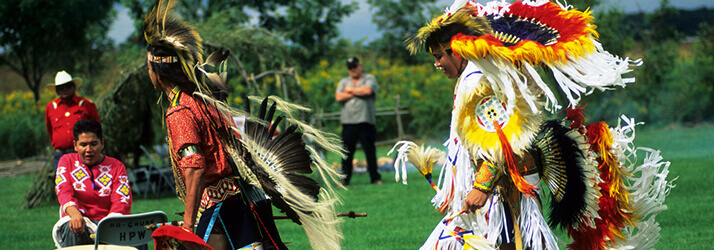
Native American Tribes and Their Involvement in Jewelry
Now let’s take a look at four Southwestern American Indian tribes who were (and still are) known for exceptional jewelry making. Each tribe has their own unique stories, as well as distinctive styles of jewelry. It is worth noting that there are so many different types of Native American jewelry that have been crafted over thousands of years in various regions, and here we will cover some of the most prevalent offerings from the Southwestern United States.
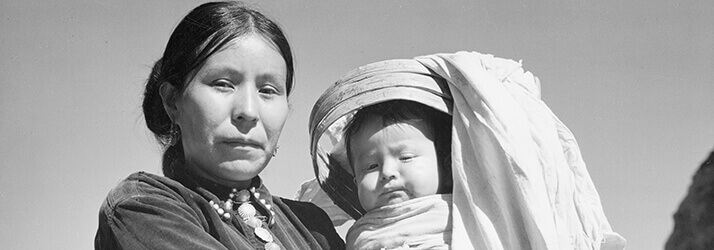
The Navajo
The Navajo is the nation’s largest Native American tribe. Unsurprisingly, this tribe’s jewelry is the most widespread and well-known today. Navajo jewelry came into its own when silver was introduced, and then it became even more desirable when turquoise was used alongside the precious white metal. Many of the early Navajo pieces were crafted from melted coins.
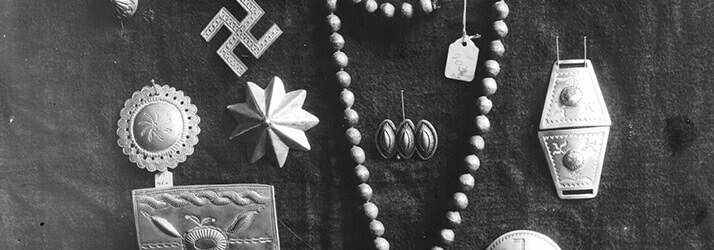
Atsidi Sani Introduces Silver to Navajo Jewelry
Navajo jewelry really took off towards the end of the 19th century when a man named Atsidi Sani started incorporating silver into his jewelry. Atsidi Sani was well-known as a blacksmith in the year 1850. He learned silversmithing from the Spanish shortly thereafter. Until approximately 1865, he was known for making bridles out of iron, and eventually he started using his new silversmithing skills to forge bracelets, conchas, and other types of Native American jewelry. As his skills progressed, he started teaching his four sons the art of silversmithing, and he became a professional, paid teacher of the craft in 1890.
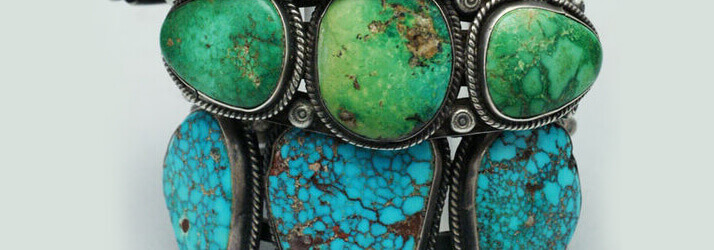
Atsidi Chon Starts Incorporating Turquoise
Atsidi Chon, or “Ugly Smith” as he was also known, was another important figure in Navajo jewelry making. In addition to teaching the Zuni tribe the art of silversmithing, he was also the first to incorporate the blue-green gemstone turquoise into his jewelry creations in the 1900s (which was by no coincidence right around the time period when the tribe started using jewelry for economic purposes).
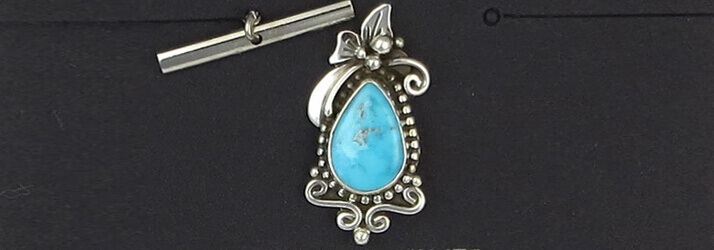
Traditional Navajo Designs
It is believed that some of the early Navajo jewelry designs came from the Spaniards. Today, the Navajo tribe’s extensive portfolio includes pieces with the tribe’s signature silver leaves, flowers, and beads, as well as hand stamp work.
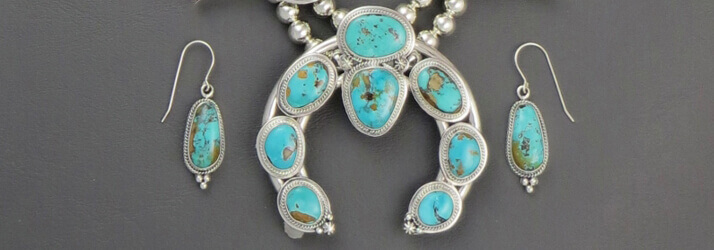
The Squash Blossom Necklace
Other types of Native American jewelry introduced by the Navajo include sandcast jewelry, naja pendants, and squash blossom necklaces. Dating back to the 1870s, squash blossom necklaces in particular are perhaps the most definitive Navajo pieces. They are comprised of a beaded silver necklace with squash blossom petal beads, and they are finished off by an oversized naja pendant on the bottom. It is believed that the design is based on the pomegranate decorative element of the colonial Spanish.
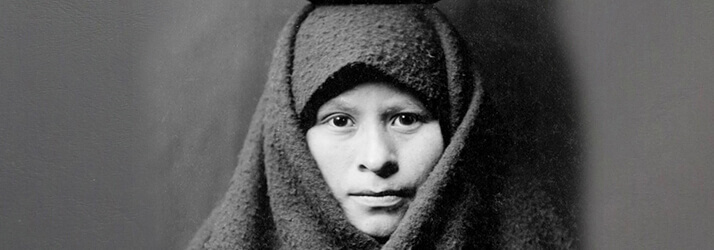
The Zuni
The Zuni tribe has crafted gorgeous, fascinating jewelry for over 1,000 years. They are most famous for their intricate stone work, with animal-themed fetishes being the most widespread. Other stone designs include petit point, needle point, and inlay. While other tribes such as the Navajo used larger, chunky stones, Zuni stones are always meticulously cut, crafted, and polished. In 1872, influence from the Navajo tribes (including the aforementioned Atsidi Chon) led to the use of silver in the Zuni’s various other types of Native American jewelry.
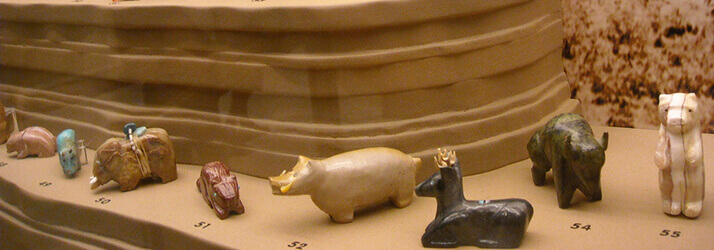
Zuni Fetishes
Since pre-Columbian times, the Zuni tribe has used natural and artificial objects called fetishes for luck, power, and protection. It is believed that an animal spirit resides in each fetish, and that is why many stone fetishes are carved into the shapes of common animals. These fetishes are used as standalone decorative objects or incorporated into different types of Native American jewelry.
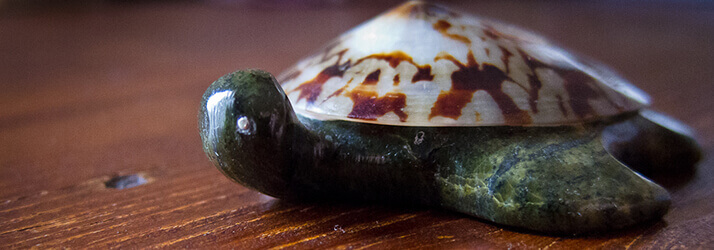
Fetish Beliefs and Care
Like most Native American tribes, the Zuni people have a strong connection with the Earth and its inhabitants. Plants and animals are often incorporated into spiritual beliefs and rituals, and fetishes are a perfect example of this. Each animal has its own unique significance, and in order for the owner to reap the benefits of each fetish, he must nurture the animal spirit by revering, feeding, and caring for the fetish.
Some owners empower and nurture the fetish’s animal spirit by placing it in a bundle with shells, stones, or arrowheads. The creator of the fetish may also add special features such as a carved or inlaid “heartline” or “lifeline,” which is an arrow-shaped line that starts at the animal’s mouth where breath and life begins, and ends at the animal’s soul or spirit where it stores its faith and inner strength.
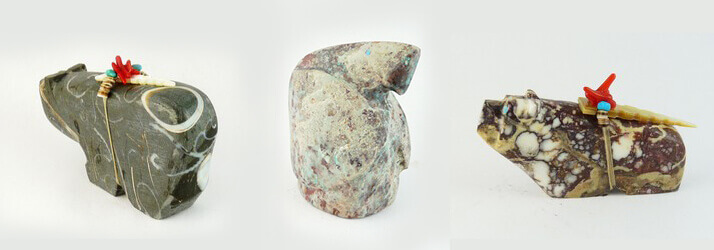
Materials Used
Just as there are countless types of Native American jewelry, there are many different types of Zuni fetishes. Materials used include jet, lapis, jasper, amber, dolomite, malachite, marble, mother of pearl, azurite, zebra stone, and many other types of stones. Turquoise is the most sacred of all the stones used, and serpentine was used most frequently. The Zuni also carved fetishes out of other natural resources such as bone, fossilized ivory, and elk or deer antlers, as well as artificial materials such as slag glass (the remaining material left after separating metal from its raw ore).
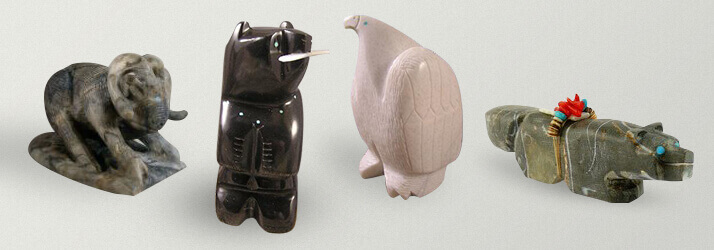
Significant Animals
Some of the most common animal carvings include the ram, eagle, mole, frog, wolf, badger, rabbit, bear, mountain lion, deer, and a myriad of others. Modern artists may carve non-traditional animals such as dinosaurs, insects, or reptiles. Although the Zuni tribe was not a horse culture, they traded horse fetishes to Northern tribes who used them for protecting their herds.
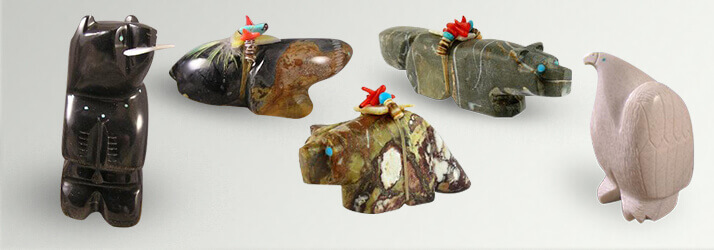
The Prey God Fetish Group
In addition to the aforementioned animals, the Zuni had some fetish groups that were especially sacred. The Zuni people divided the universe into six regions or directions: north, south, east, west, above, and below. Each region’s center has a sacred mountain peak of a corresponding color that is protected by a guardian animal or a Prey God.
- The yellow northern mountains are guarded by the mountain lion.
- The red southern mountains are guarded by the badger.
- The blue western mountains are guarded by the black bear.
- The white eastern mountains are guarded by the wolf.
- The multi-colored mountains in the upper region are guarded by the eagle.
- The black mountains in the lower region are guarded by the mole.
The Prey Gods of the Hunt Fetish Group
Another extremely sacred fetish group is the Prey Gods of the Hunt, which was used by the hunters in the ritual called “prayer songs of the Sa-ni-a-kia-kwe.” This group of fetishes was especially important because the Zuni believed that the power of these animals’ strong hearts helped the tribesmen to remain the hunters and prevent them from becoming the hunted. The animals included in the Prey Gods of the Hunt group are the same as those in the aforementioned Prey God group, with the badger replaced by the wildcat or bobcat, and the black bear replaced by the coyote.
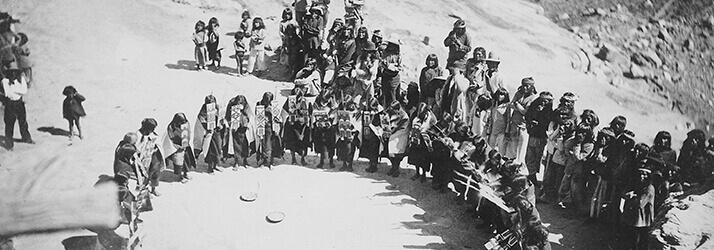
The Hopi
Although they are also known for various other types of Native American jewelry, as well as textile weaving, coiled baskets, and Katsina carvings, the Hopi tribe is most famously known for their distinctive silver “overlay” style. Until the 1930s, the Hopi tribe only had access to very limited silver quantities, so the majority of their jewelry was crafted from shell, wood, seeds, bone, turquoise, and other stones.
Sileyatala of Walpi was the first Hopi to learn silversmithing from the Zuni tribe in 1898, and the silverwork that the tribe produced was virtually identical to the types of Native American jewelry made by the Navajo and Zuni. Until the 1930s, the Hopi did not have their own distinctive style, and very few Hopi were skilled in silversmithing.
Hopi “Overlay” Jewelry
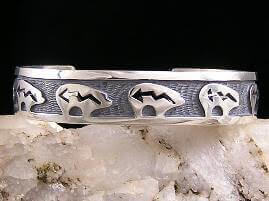
In the 1930s, the Hopi started crafting their own distinctive style of jewelry called inlay. They would take two similarly shaped pieces of silver, and carve designs influenced by traditional baskets, textiles, and pottery into the top silver layer. The silversmith would oxidize the bottom silver layer so that it would turn black, and then solder the top layer to the blackened bottom piece, letting the design show through. This creates a unique and highly desirable aesthetic, while also ensuring that the resulting piece of jewelry is extremely durable.
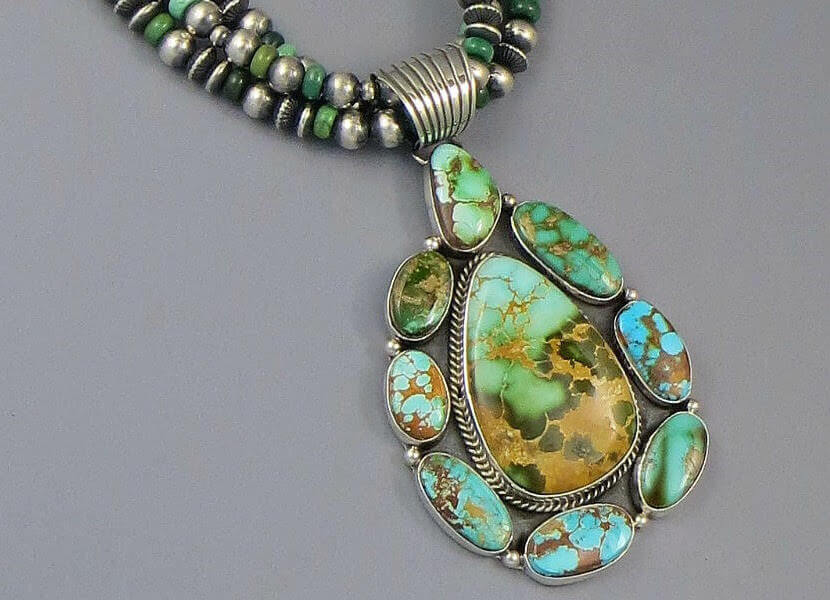
The Significance of Turquoise
Hopi inlay jewelry is usually just silver, but some special pieces incorporate turquoise. This blue-green, semi-precious stone is synonymous with Native American culture, and it still holds a special significance in Hopi culture today. Most types of Native American jewelry incorporate turquoise in some way, and this influence can be traced as far back as 200 B.C. when it was used by the Hohokam and Anasazi people who lived in what is now Arizona and New Mexico.
Turquoise is known as the “stone of life,” representing good fortune and wealth. It was often used in rituals and ceremonies. For example, a traditional Hopi household often had bags of turquoise hanging throughout the house to ward off evil. Hopi hunters were also known to tie a small pouch of turquoise around their neck when hunting to promote good luck, and Hopi warriors wore it into battle as protection.
As you learn about turquoise and the many other types of Native American jewelry, it is so fascinating to consider the deep, spiritual meanings that each piece once conveyed, as well as the personal significance that is still very much relevant to jewelry collecting today. While we may have deeper scientific knowledge of the world today, there will always be something inherently special—and even magical—about owning a one-of-a-kind piece that really speaks to you.
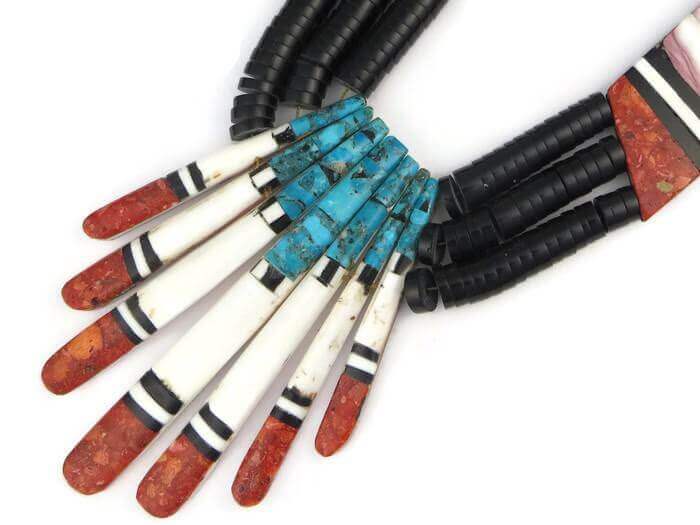
The Santo Domingo
Descendants of the ancient Anasazi people, the Santo Domingo tribe is known for their shell, silver, and turquoise jewelry. Their “heishe” beads are their most famous contribution to the jewelry world, although other types of Native American jewelry produced by the Santo Domingo people include their signature thunderbird necklaces and mosaic inlay on shell or bone. In 1893, Ralph Atencio became the first Santo Domingo silversmith.
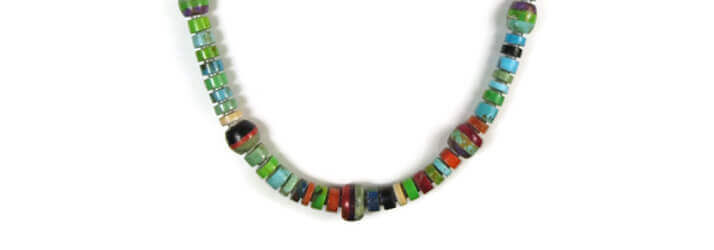
Heishe (or Heishi) Beads
The word “heishe” means “shell bead” in the Eastern Keresan language of the Santo Domingo Indians. These small tube or disc-shaped beads are crafted out of shell and turquoise or other polished stones. The Santo Domingo bead makers would grind, drill, and string these gorgeous beads all by hand. Although many heishe beads are produced by machine today, there are still Santo Domingo artists who continue to make various types of Native American jewelry entirely by hand, including the often labor-intensive heishe beads.
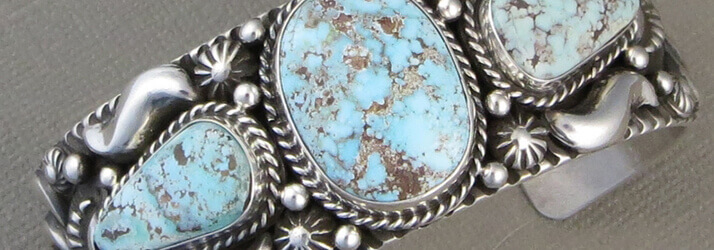
Where to Buy Authentic Native American Jewelry
At Southwest Silver Gallery we sell genuine Native American jewelry sourced from local Zuni, Navajo, Hopi, and Santo Domingo tribes, as well as gorgeous handcrafted pieces influenced by American Indian history and culture. We proudly offer a wide variety of exquisite bracelets, earrings, necklaces, rings, silver chains and beads, and so many other authentic types of Native American jewelry. We also carry pendants, crosses, rosaries, Zuni fetish carvings, and other keepsakes.
Most of our pieces are hallmarked by master artists, and all of our turquoise is 100% genuine. To ensure complete transparency, we encourage you to contact our experts if you have any questions at all about the source of any of our authentic products. To inquire about our fine jewelry, please call 1-888-476-4367 or simply send us a message online. Add a stunning piece of Native American history to your jewelry collection today.
